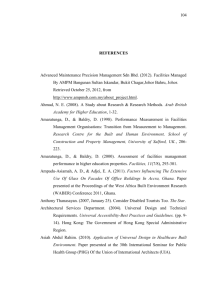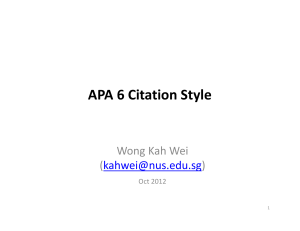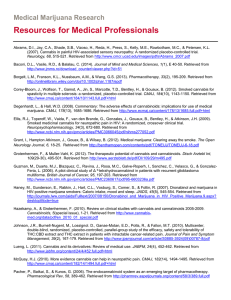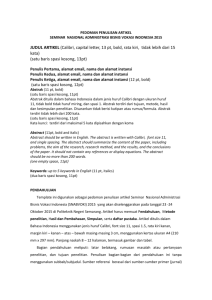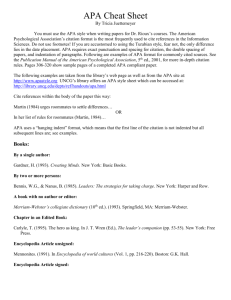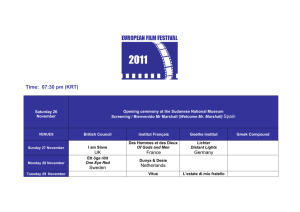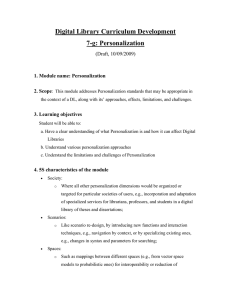BIBLIOGRAPHY Applebee, A.N. (1978). The Cild Concept of Story
advertisement
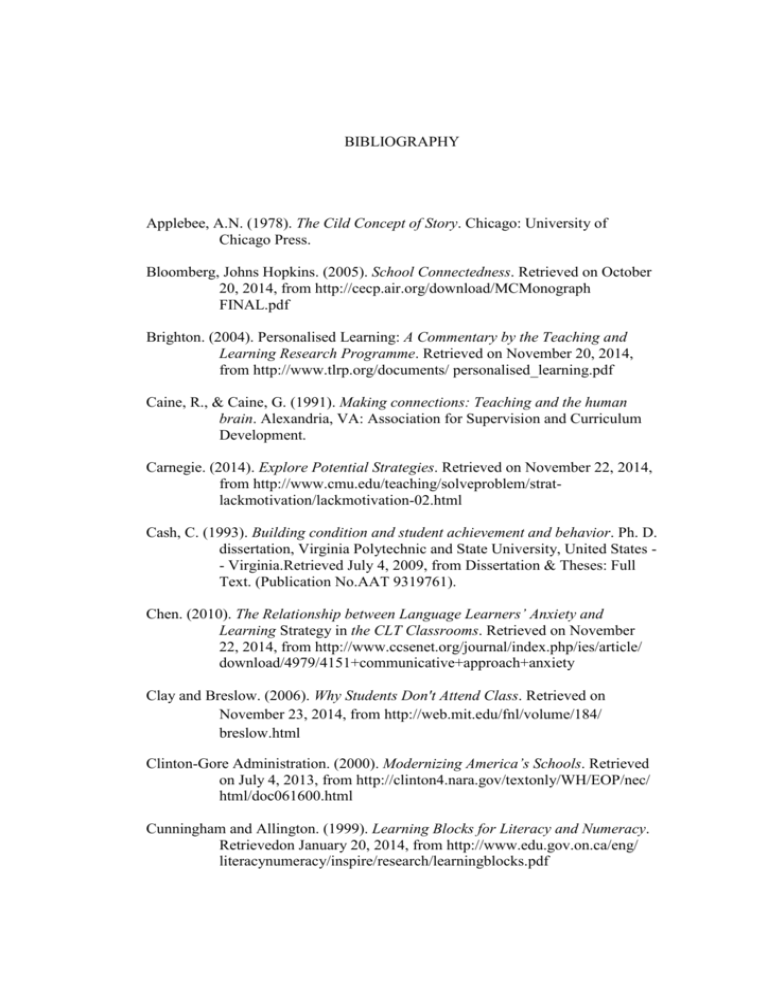
BIBLIOGRAPHY Applebee, A.N. (1978). The Cild Concept of Story. Chicago: University of Chicago Press. Bloomberg, Johns Hopkins. (2005). School Connectedness. Retrieved on October 20, 2014, from http://cecp.air.org/download/MCMonograph FINAL.pdf Brighton. (2004). Personalised Learning: A Commentary by the Teaching and Learning Research Programme. Retrieved on November 20, 2014, from http://www.tlrp.org/documents/ personalised_learning.pdf Caine, R., & Caine, G. (1991). Making connections: Teaching and the human brain. Alexandria, VA: Association for Supervision and Curriculum Development. Carnegie. (2014). Explore Potential Strategies. Retrieved on November 22, 2014, from http://www.cmu.edu/teaching/solveproblem/stratlackmotivation/lackmotivation-02.html Cash, C. (1993). Building condition and student achievement and behavior. Ph. D. dissertation, Virginia Polytechnic and State University, United States - Virginia.Retrieved July 4, 2009, from Dissertation & Theses: Full Text. (Publication No.AAT 9319761). Chen. (2010). The Relationship between Language Learners’ Anxiety and Learning Strategy in the CLT Classrooms. Retrieved on November 22, 2014, from http://www.ccsenet.org/journal/index.php/ies/article/ download/4979/4151+communicative+approach+anxiety Clay and Breslow. (2006). Why Students Don't Attend Class. Retrieved on November 23, 2014, from http://web.mit.edu/fnl/volume/184/ breslow.html Clinton-Gore Administration. (2000). Modernizing America’s Schools. Retrieved on July 4, 2013, from http://clinton4.nara.gov/textonly/WH/EOP/nec/ html/doc061600.html Cunningham and Allington. (1999). Learning Blocks for Literacy and Numeracy. Retrievedon January 20, 2014, from http://www.edu.gov.on.ca/eng/ literacynumeracy/inspire/research/learningblocks.pdf Enciso, P.E. (1997). Negotiating the Meaning of difference: A.O. Soter (Eds.), Reading across Cultures: Teaching Literature of Diverse Society (p. 13-41). New York: Teacher College Press and Urbana, IL: National Council of Teacher of English. Galda, L. (1992). Evauation as a Spectator: Changes Across Time and Genre. In J. Many & C. Cox (Eds.), Reader Stance and Literature Understanding: Exploring the Theories, Research, and Practice (pp. 127-132). Norwood, NJ: Ablex. Graham, J.W. (1985). The Effect of Reading Ethnic Literature on the Attitudes of Adolescents. (Doctoral Dissertation, Georgia State University, Atlanta, 1985.) Dissertation Abstracts International, 46(12), 3636A. IDEA Education. (2012). Stimulated Students to Intellectual Effort Beyond That Required By Most Courses. Retrieved on November 18, 2014, from http://ideaedu.org/research-and-papers/pod-idea-notesinstruction/idea-item-8-stimulated-students-intellectual-effort Jordan, S. (1997). Student Responses to Culturally Diverse Text. In G. Cruz, S. Jordan, J. Melendez, S. Ostrowski, & A.C. Purves, Beyond the Culture Tour: Studies in Teaching and Learning with Culturally Diverse Texts (pp. 9-34). Mahwah, NJ: Erlbaum. Julie Deneen. (2013). 25 Things Successful Educators Do Differently. Retrieved onOctober 15, 2014, from http://www.opencolleges.edu.au/informed/features/25-thingssuccessful-educators-do-differently/ Ketsman. (2012). Expectations in the Foreign Language Classrooms: A Case Study. Retrieved on November 14, 2014, from http://www.nova.edu/ssss/QR/QR17/ketsman.pdf Kohn.(2004). Supporting Good Teaching Practices with Neuroscience. Retrieved on October 14, 2014, from http://www.ascd.org/publications/ educational-leadership/summer07/vol64/num09/the-neuroscience-ofjoyful-education.aspx Ladson-Billings, Gloria.(1994). Culturally Relevant Teaching. Retrieved on November 10, 2014, from http://www.learnnc.org/lp/pages/4474 MacLean. (1997). A Translation Technique. Retrieved on November 14, 2014, from http://dosfan.lib.uic.edu/usia/EUSIA/forum/vols/vol37/ no1/p2.htm Many, J.E., & Wiseman, D.L. (1992). Analyzing Versus Experiencing: The effects of teaching Approaches on The Students’ Responses. In J. Many & C. Cox (Eds.), Reader Stances and Literary Understanding: Exploring the Theories, Research, and Practice (pp.250-276). Norwood, NJ: Ablex. McNiff, Jean. (2002). How can I help students who are comparatively poor at English. Retrieved on October 29, 2014, from http://www.actionresearch.net/living/moira/MaHong.htm Miriam, et.al.(2002). Changes in the Teaching and Learning Process in a Complex Education System. Retrieved on November 14, 2014, from http://www.necsi.edu/research/management/education/teachandlearn.h tml\ Mudarwan.(2014). MenimbangUlang Proses Penilaian di Sekolah.Retrieved on November 1, 2014, from (http://www.bpkpenabur.or.id/files/Hal. %2097-106%20Mutakhir%20Kurikulum.pdf Naidoo, B. (1992). Through Whose Eyes? Exploring Racism: Reader, Text, and Context. Chester, UK: Trentham Books. Neus. (2013). Report and evaluation of the development of CLIL Programmes in Catalonia. Retrieved on November 14, 2014, from http://www.academia.edu/6332091/Report_and_evaluation_of_the_de velopment_of_CLIL_Programmes_in_Catalonia Ontario Curriculum. (2009). The Arts The Arts. Retrieved on October 17, 2014, from http://www.edu.gov.on.ca/eng/curriculum/elementary/ arts18b09curr.txt Ontario Ministry of Education. (2004a). Literacy for learning: The report of the expert panel on literacy in Grades 4 to 6 in Ontario. Toronto, ON: Queen’s Printer for Ontario. Perkins.(1992). Teaching for Understanding. Retrieved on October12, 2014, from http://www.exploratorium.edu/ifi/resources/workshops/teachingforund erstanding.html Prairie. (2013). A Guide to Programming for Gifted Learners: A Handbook for Schools. Retrieved on November 16, 2014, from http://www.gpcsd.ca Qiaoyan, et al. (2011). Promoting a special learning environment for second language learning in a Chinese rural primary school. Retrieved on November 14, 2014, from http://www.academia.edu/1822850/Promoting_a_special_learning_en vironment_of_second_language_learning_in_a_Chinese_rural_primar y_school Robert. (2008). Educating Everybody's Children: Diverse Teaching Strategies for Diverse Learners, Revised and Expanded 2nd Edition. Retrieved on November 16, 2014, from http://www.ascd.org/publications/books/ 107003/chapters/Educating-Everybody%27s-Children@-We-KnowWhat-Works%E2%80%94And-What-Doesn%27t.aspx Rogers, T. (1991). Students as Literary Critics: The Interpretative Experiences, beliefs, and Process of Ninth-Grade Students. Journal of Reading Behavior, 23, 391-423. Syawal.(2013).KemendikbudRekrut 666 InstrukturuntukPelatihanKurikulum 2013.Retrieved on October 30, 2014, from http://litbang.kemdikbud. go.id/sekretariat/index.php/ home/arsipberita1?view=archive Szulc-Kurpaska’s (2000).Classroom Interaction and Communication Strategies in Learning English as a Foreign. Retrieved on October 25, 2014, from http://www.sdas.edus.si/ Elope/PDF/ElopeVol1Dagarin.pdf Tobin, B.J. (1989) The Responses of Early Adolesent, White Australian Reader to Selected Cross-Cultural, Folklore-Based Fantasy Novel by Patricia Wrightson. (Doctoral dissertation, University of Georgia, Athens, 1989). Dessertation Abstract Internaional, 50(06), 1586A. UNESCO. (2006). Practical Tips for Teaching Large Classes: A Teacher’s Guide. Retrieved on November 23, 2014, from http://unesco.org.pk/education/icfe/resources/res15.pdf
